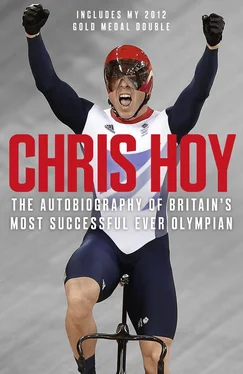Though I had my own room, Jason and I shared the apartment, and the shower. Not at the same time, I should clarify. But Jason, being more of a morning person than me – which isn’t saying much – was in there first, and so I waited, then showered, before joining Jason to ride down to the canteen for breakfast.
It’s not as though it was far. It was only a few minutes’ journey, but cyclists abide by a set of absolute golden rules. Never stand when you can sit. Never sit when you can lie down. And never walk when you can cycle. At this stage of the competition, in particular, it is a case of trying to preserve all the energy and strength you can.
We freewheeled down to the canteen in silence, arriving at the entrance and locking up our bikes. It might be the Olympic athletes’ village, with stricter security than the Pentagon, but you still lock your bike. You can never be too careful – especially with a £3,000 road bike.
Looking back now, this would have been a quite surreal scene: Jason and I heading off to breakfast together, like best mates, as if there were nothing out of the ordinary about the day ahead. It probably helps that Jason must be one of the most relaxed people in the team, if not the sport: nothing seems to faze him, and he is famous for his languid and laidback style (off the track, I should point out: on it, his reactions are a little bit faster).
Both of us knew there was a chance that, just a few hours later, we would race each other for an Olympic gold medal, in arguably the most prestigious of the track cycling events, the sprint. We had qualified first and second in the initial 200m time trial two days ago, and we had both progressed reasonably comfortably to the semi-finals – separate semi-finals, with the German rider Max Levy as Jason’s opponent, and Mickaël Bourgain of France as mine. Beat them and we’d be meeting again a few hours later, in an Olympic final.
But neither of us mentioned any of this. We didn’t talk about racing at all. We just chatted about the usual things, and spent breakfast engaged in the activity that occupies so much of your down time at the Olympics: people watching. This is a particularly entertaining and enjoyable pastime in the athletes’ village, where you get famous names, some extraordinary shapes and sizes, which inspire games of ‘guess the sport.’
Thus did Jason and I pass this very ordinary hour on this most surreal of days, before returning to our apartment, to prepare for the 40-minute bus journey to the Laoshan Velodrome, on the outskirts of Beijing.
First, though, I paid a visit to the British team’s sprint coach, Jan van Eijden. Jan, from Germany, was the world sprint champion in 2000. He retired in 2006 and came to work for us the following year, having been poached from the Eurosport commentary box by our head coach, Shane Sutton, who reckoned Jan had the ingredients to become a top coach. Though he wasn’t the fastest in the world, Jan consistently won head-to-head ‘match’ sprint races. Tactically, I would argue that he is the best sprinter of the last decade. And Shane was right, as he often is (and sometimes isn’t): Jan’s knowledge and experience make him a brilliant tactical coach, and a real asset to the British team. Added to which is the fact that he is very upbeat and virtually always smiling. So he – like the incredible force of nature that is Shane Sutton – is also good for morale.
But this morning I wasn’t going to see Jan to have my morale lifted, or to ask, in the eventuality of us meeting in the final, how I might beat Jason. I knew he wouldn’t discuss Jason’s tactics – and in any case, I wasn’t thinking of Jason … yet. I was thinking of my semi-final opponent, Bourgain.
Before any race, we watch videos of our opponent in action. So Jan got his computer out, and together we watched every sprint race I had ever ridden against Bourgain. We looked for potential weaknesses (his, but also mine). I’d watched all these videos numerous times before. But this, I suppose, was like looking over your notes before an exam. It’s probably not going to make much difference (‘if you don’t know it now, you’ll never know it,’ as the mantra used to go before exams), but, as in the anxious pre-exam wait, you think that you should be doing something. It feels better than doing nothing.
The videos for Beijing were prepared by our performance analysts: there were hours and hours of races on film, over 300 gigabytes’ worth; files and files, comprising a complete library, with every opponent racing and just about every scenario you could imagine. But the analysts’ work goes way beyond just having all this stuff on film. They’ve studied it and worked out things like, ‘If Bourgain is leading with half a lap to go there’s an 80 per cent chance he’ll win the race …’ or ‘When he’s behind his opponent with two laps to go, there’s a 30 per cent chance he’ll win.’ All these statistics and data (‘the numbers’, as we call them) have been prepared by the Great Britain team’s performance analysts – go to any World Cup meeting and you’ll see them sitting quietly at the back of the stand with a tripod, filming every single race.
The thing is, a head-to-head match sprint race will often come down to intuition and what we call track craft – the fast/slow feinting and cat-and-mouse tactics that you see between two riders – but it’s reassuring to have the statistics to back it all up; it can give you extra confidence in your game plan.
As Jan and I sat and watched the footage of my previous races against Bourgain, we focused on a couple in particular. One was at the same Laoshan Velodrome, at the Beijing World Cup the previous December. At that point, I was still taking my first, tentative steps as a sprinter. At 31, I was a bit old, really, to be trying something new – or so the accepted wisdom went. Match sprinting – since it demands the explosive acceleration of a Usain Bolt coupled with the quick reflexes and agility of an Olga Korbut – was seen as a young man’s game (and I’m no Olga Korbut). But having lost my specialist event, the kilometre, I was determined to add another string to my bow.
And that’s really all I was thinking back in December 2007, at that World Cup in Beijing. The team sprint remained my priority as I looked ahead to the Olympics, while the keirin, in which I was also a relative novice, and the sprint gave me other options. My thinking was that if I could do all three events, I’d increase my chances of being selected for the team sprint. But at that point the idea that I could challenge for a medal in all three seemed like a pipe dream. I was expecting to be competent and competitive, nothing more.
And I still had some distance to go, if my meeting with Bourgain in the quarter-final of the 2007 Beijing World Cup was anything to go by. He beat me in two straight rides. Both rides were quite close, as it happens, but the bare statistics don’t lie. Two-nil is a comprehensive beating. And it was to be expected: Bourgain, a 28-year-old Frenchman best described as a ‘pure sprinter,’ was certainly one of the top two or three in the world, having medalled in every world championship since 2004.
The other race Jan and I watched was from two months later, when I met Bourgain again, this time at the World Cup in Copenhagen. This was the race that offered the first sign that I might yet make it as a sprinter. Shane Sutton, in typically excitable and enthusiastic style, told me it was ‘the turning point – the moment you became a sprinter’. Reminiscing about it months later, he seemed even more convinced about this. ‘What was the critical race?’ he’ll ask – expecting whoever he is asking to reply that it was my defeat of reigning world champion Theo Bos, the Dutchman who dominated sprinting in recent seasons, in the quarter-final of the world championships in Manchester a few weeks after that Copenhagen World Cup.
Читать дальше












